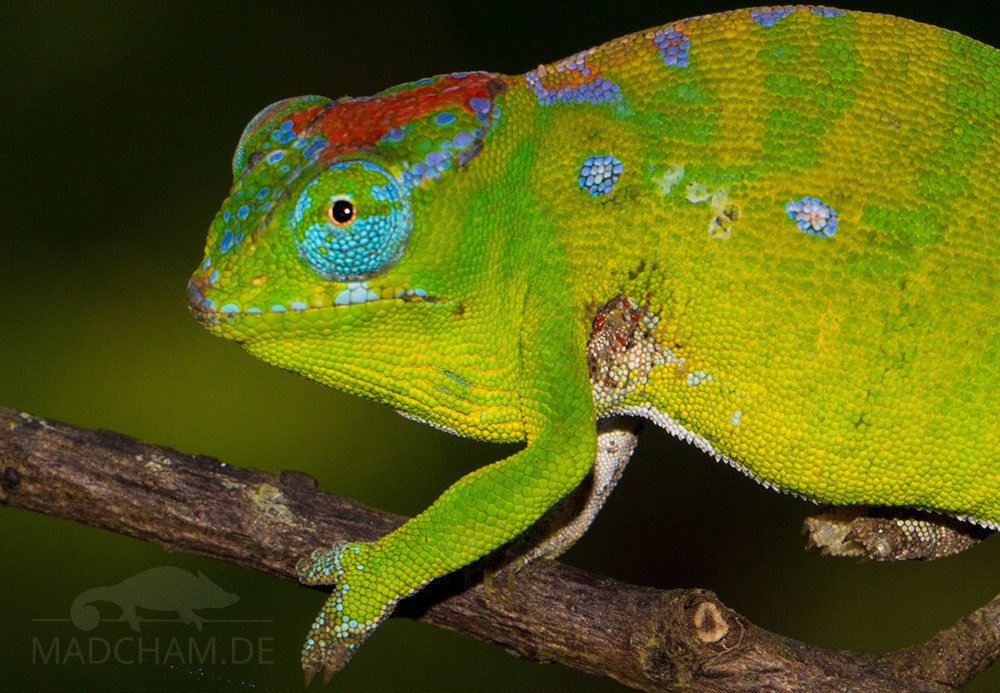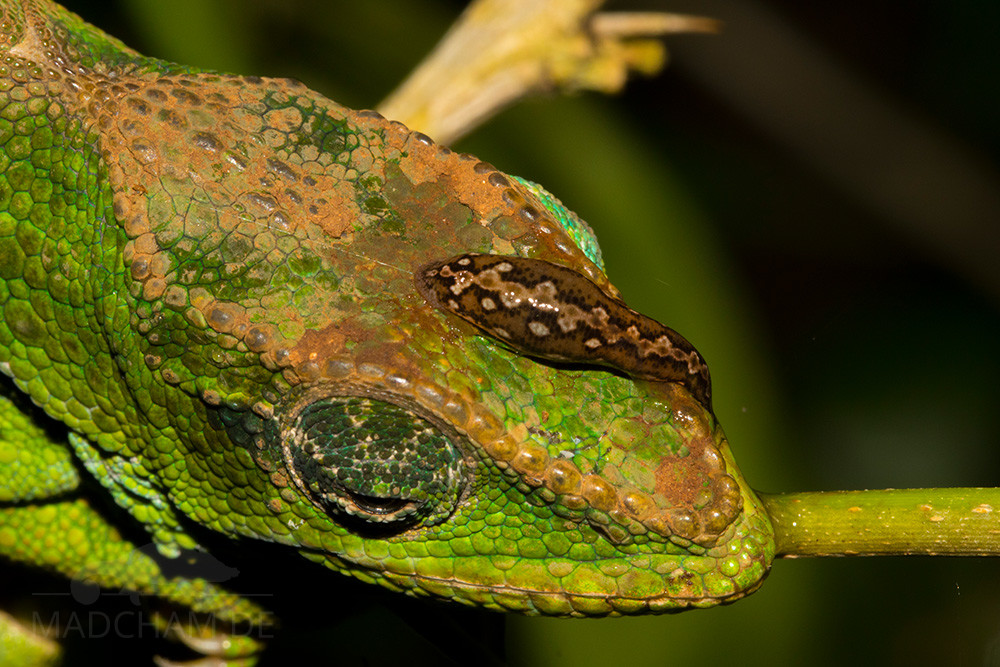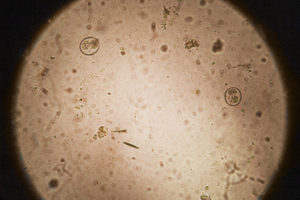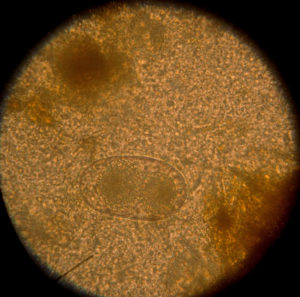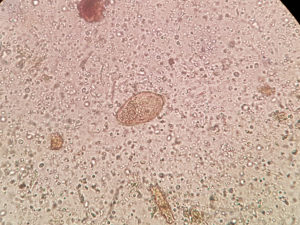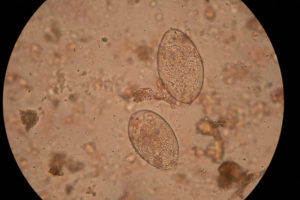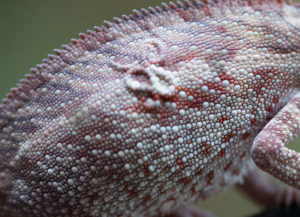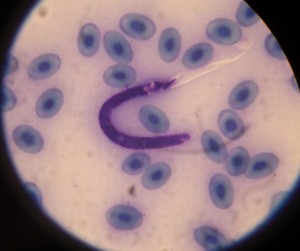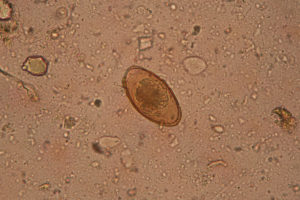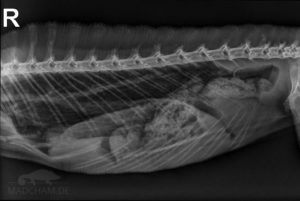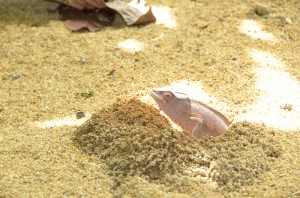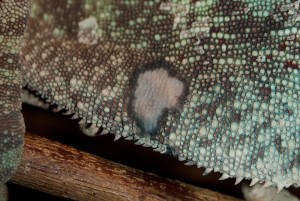Parasites are a common problem in chameleons, especially in wild-caught chameleons or captive-bred animals from large breeding stocks. Basically, you distinguish between endoparasites, which colonize the inside of a chameleon, and ectoparasites, which are only found on the skin of the animal. Parasites are differently “pathogenic” for chameleons: some are very harmful even at low infestation, others are rather harmless. By the way, very few endoparasites can be seen with the naked eye in the feces.
This article is intended to give an overview of the parasites found in chameleons, their transmission, and their life cycle. Treatment options are not recommended here, as both diagnosis and treatment of a parasite infestation should always be discussed with a veterinarian knowledgeable in reptiles. Almost all of the endoparasites presented here can be detected in fecal examinations. But be careful: if nothing was found in the feces, it does not automatically mean that the chameleon is free of parasites! Many parasite stages are not constantly excreted in the feces. A single fecal sample is therefore not sufficient to rule out endoparasite infestation.
Inhaltsverzeichnis
Endoparasites
Coccidia
The specter of chameleon husbandry: every second major husbandry has problems with coccidia. Coccidia are single-celled organisms. A distinction is made between Eimeria spp. and Isospora ssp. and Cryptosporidia. The infective stages of coccidia are called sporulated oocysts. Oocysts are present in large quantities in the feces of infected chameleons. So if the infected chameleon defecates, a lot of coccidial oocysts invisible to the human eye also end up in the environment. They may stick to branches over which the chameleon has rubbed its cloaca, to foliage or soil on which the droppings have fallen. Insects that walk over the feces can carry the oocysts further around. The next chameleon becomes infected with these oocysts by eating such an insect, accidentally ingesting a leaf with oocysts, or licking over a branch. Even during hatching, a chameleon can become infected: Namely, if the mother animal had coccidial oocysts in its cloaca during egg-laying. There the oocysts get onto the eggshell and later during hatching to the young animal. Infection via contaminated drinking water or objects to which oocysts adhere is also possible.
The coccidial oocysts are ultimately swallowed and enter the intestine. There they release what is called sporocysts. The sporocysts release vast quantities of sporozoites. These in turn can penetrate the mucosa of the chameleon’s intestine. From there, they migrate to the body tissue where the particular type of coccidia continues to develop. In the case of Choleoeimeria, for example, this is the bile duct and gall bladder; in the case of other coccidia, it is the kidneys. The sporozoites now cause the coccidia to multiply: they become trophozoites, then schizonts, which then releases merozoites. These are all names for certain developmental stages of the coccidia, but ultimately they are not that interesting to the chameleon. Actually, it is the merozoites that are most important, because these either infect other intestinal cells or develop into gametes, two of which each form a new oocyst. These oocysts are excreted through the intestine with the chameleon’s feces. Thus the cycle of the parasites starts all over again.
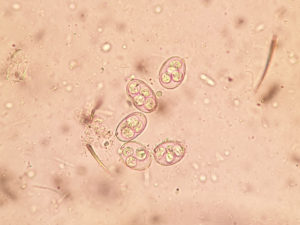
Choleoeimeria oocysts in the feces of a Brookesia stumpffi, 100x magnification
Often a coccidial infection is self-limiting: Adult chameleons often develop a stable immunity in which the animals show no signs of disease. However, under stress such as mating, change of location, or suboptimal housing conditions, coccidia can multiply particularly well. Then they can lead to severe diseases, including intestinal inflammation and diarrhea. Because every chameleon experiences events during its life that can lead to a multiplication of coccidial infestations, coccidia should never be considered harmless.
Coccidial oocysts of Eimeria and Isospora are unfortunately extremely long-lived. Under favorable conditions, they remain infectious for over a year. For the oocysts to sporulate and become infectious, they require moisture and warm temperatures. The optimum for sporulation is 25-30°C, below 10°C development is arrested. Cryptosporidia are even more resistant. They survive cold to -20°C and heat to 65°C. At 5°C they can remain infectious for up to five years (!). Coccidia are resistant to most chemical disinfectants. Sterilium, which is used for hand disinfection in humans, or the common disinfectants for terrariums in pet shops are unfortunately useless against coccidia. Chlorocresol should only be used in consultation with a veterinarian due to its harmful effects. The high resistance to “simpler” disinfection options and lack of quarantine are probably reasons why coccidia are unfortunately very widespread in chameleon keeping.
Caution: Coccidia represent a zoonosis in a limited context. This means that they can theoretically be transmitted from animals to humans. For example, cryptosporidia can cause severe diarrhea in immunocompromised individuals (children, pregnant women, the elderly, or the sick). Practically, this does not tend to occur in chameleon husbandry because the commonly found species are relatively host-specific. Nevertheless, as a precaution, it is recommended to pay attention to very good hand hygiene in chameleons with coccidia and cryptosporidia infestation.
Amoebae
Amoebae are a very large group of protozoa. Only a very few are pathogenic to chameleons, including Entamoeba invadens. This amoeba is highly infectious, meaning it spreads extremely easily. The reproductive stages of amoebae are called cysts. These cysts are present in large numbers in the feces of infected chameleons. Infected chameleons defecate in the environment, where, for example, branches, insects, or simply soil come into contact with the cysts. The next chameleon becomes infected by ingesting these cysts from the environment, for example during a tongue test or when it shoots an insect that has previously passed over the feces. The cysts, invisible to the human eye, are swallowed and eventually end up in the chameleon’s large intestine. There they develop into the so-called trophozoite. This is the life stage of the amoeba in which it can reproduce. Entamoeba invadens invades the wall of the large intestine. From this, the chameleon can get severe bloody intestinal inflammation. This in turn leads to emaciation, dehydration, and sometimes even slow death of intestinal parts. Via small blood vessels in the intestinal walls, the amoebae reach other organs such as the liver and kidneys through the bloodstream. There, too, they cause severe inflammation and, in advanced stages, ultimately lead to the failure of the organ in question. Meanwhile, the infective cysts constantly leave the sick chameleon with feces. The entire disease is called amoebiasis.
But there is another way: Some chameleons have such a good immune system that the amoebae only survive in the colon. So these chameleons do not get sick immediately with the amoeba infection. However, if at a later point in the chameleon’s life it becomes immunocompetent, for example, due to stress such as a change of location or mating, the amoebae take advantage of this. They then multiply abruptly and cause the already explained amoebiasis.
Since Entamoeba invadens develops optimally at 27-29°C body temperature, only reptiles are affected by these amoebae. Humans can get the so-called amoebic dysentery (bad diarrhea) from another amoeba called Entamoeba histolytica, but not from Entamoeba invadens. So this parasite is dangerous to chameleons, but not to humans. Amoebic cysts survive in the soil for at least eight days and can be carried by feeding insects or clinging to objects. Here you can read how to get rid of amoebae.
Ciliates
Ciliates are found in the feces of many chameleons. Most species are harmless for chameleons. Only under poor husbandry conditions, they can become a problem in individual cases of mass infestation. Among the better-known ciliates are Nyctotherus spp. and Balantidium spp. which both use cysts as a reproductive stage.
Flagellates
Flagellates is an umbrella term for a whole range of motile unicellular organisms. They are characterized primarily by long cell processes with which they can move around – the so-called flagella. Some of these protozoa are found in the feces of chameleons without any disease at all. Others require treatment because they can lead to disease, even if no symptoms are currently visible in the chameleon. Flagellates are present in large numbers in the feces and urate of infected chameleons. In addition, flagellates form so-called cysts. These are non-motile but remain infectious even under adverse conditions. The chameleon’s excreta containing flagellates and cysts end up on the ground. The cysts stick to leaves, branches, plants, or moss. If another chameleon now ingests cysts with a food animal, it becomes infected with the flagellates. Transmission is also possible during mating when the hemipenis of the male chameleon is inserted into the cloaca of the female.
Ingested through the mouth, the cysts enter the intestine and develop into flagellates again. From there, flagellates such as Monocercomonas can infect the liver in addition to the intestine or migrate via blood vessels to the lungs. Leptomonas, on the other hand, occupy the intestinal walls. The infected tissues become inflamed. Via the cloaca, certain flagellates such as Hexamita enter the ureters and finally the kidneys. An infestation with only a few flagellates is often overlooked at first because the chameleon shows no signs of disease. However, as the disease progresses, Hexamita, for example, damages the kidneys and causes chronic inflammation, while Leptomonas causes bloody intestinal inflammation. Eventually, this can lead to the death of intestinal and kidney cells and thus to kidney failure or the death of intestinal tissue. The same happens in other species with other organs of the chameleon body.
Microsporidia
Microsporidia are tiny protozoa belonging to the fungi. They live inside the body cells of infected chameleons. Microsporidia reproduce by cell division, called merogony. The more microsporidia present in a cell, the more it swells and unites with other infected cells to form the so-called syncytium. The infectious stage of microsporidia are spores. With these, neighboring cells of the same, already infected chameleon are infected as well as other chameleons. Spores are excreted with feces and urine and get on the ground, branches, and leaves. Infection occurs via droplet infection with spores or via air containing spores or, in (non-Malagasy) viviparous chameleons, directly in the laying gut from the female to the offspring. Microsporidia are rarely a problem in chameleons but can lead to the death of the animal if an infestation occurs. Most commonly, the genus Pleistophora is found. The cyst-like spores of these protozoa are found in muscles and other tissues.
Trematodes
Trematodes are parasitic flatworms. They usually have a flat, leaf-shaped body and suckers on the ventral side. Trematodes’ eggs are excreted by infected chameleons in their feces, rarely with urate. If the feces falls on moist soil in a small puddle or any other collection of water, ciliated larvae (miracidia) hatch from the eggs. The ciliated larvae then bore into the tissues of their intermediate host, such as certain snails. In the intermediate host, they develop into an incubating tube (sporocyst) that ultimately produces tail larvae (cercariae). The intermediate host – let’s stick with the snail – must then be ingested and swallowed by a chameleon in order to infect the chameleon with trematodes. The chameleon cannot become infected by the trematodes eggs themselves, but only ever by the tail larvae in the intermediate host. Some trematodes even require two different intermediate hosts. This also explains why mainly wild living chameleons on Madagascar are affected by trematode infestations. Trematodes are practically not found in captivity, because they lack the intermediate hosts to develop in the terrarium.
Among the trematodes, especially the Spirorchiidae are pathogenic for chameleons. The tail larvae ingested with an intermediate host develop further in the intestine of the chameleon into the adult trematodes. These migrate into the intestinal walls and invade blood vessels. The worms can clog very small blood vessels. In the worst case, this can lead to the death of affected organs.
Cestodes (tapeworms)
Tapeworms also belong to flatworms. They consist of a long, flat body. At one end, tapeworms carry a hooked ring with suction cups, the so-called scolex. The other end of the body is divided into many small segments called proglottids. Each proglottid is hermaphroditic with male and female sex organs. Tapeworms live in the intestines of chameleons, to the walls of which they attach themselves with their suckers. They ingest food over their entire body surface. The proglottids fertilize each other and are then separated from the rest of the tapeworm body. They then leave the infected chameleon with the feces. The feces falls on soil, moss, or foliage. Each individual proglottid is filled to the brim with eggs. These eggs hatch into six-hooked larvae, which must then be ingested by an intermediate host. In the intermediate host, the tapeworm larvae lodge in the connective or muscle tissue in the form of a cyst (metacestode). If the intermediate host is now eaten by the chameleon, the metacestode passes through the stomach into the chameleon’s intestine. There, it eventually develops into a tapeworm. A few species also colonize the gallbladder. Most important for chameleons are the Pseudophyllidae, which even require two intermediate hosts for their development. The first intermediate host is always a small crustacean, for example, a water flea. This is then ingested by a second intermediate host, which in turn is eaten by the chameleon. Captive-bred chameleons usually cannot get tapeworms due to a lack of suitable intermediate hosts. However, chameleons in Madagascar or exported wild-caught chameleons may have a tapeworm infestation.
Nematodes (threadworms or roundworms)
Threadworms look exactly as their name suggests. They are small, elongated, and thin. There are more than 20,000 different species, only a few of which live as parasites. Nematodes reproduce sexually. Females and males mate, then the female forms eggs. These eggs are excreted in the feces of infected chameleons. A larva develops in each egg. In nematodes, the different stages of the larva are called L1, L2, L3, L4, and the preadult stage is called L5. Between each new stage is a molt of the larva. The fifth larva, L5, finally matures into the adult nematode.
Noteworthy in nematodes is the ability to hypobiosis. This term refers to an interruption of development at the stage of the third, fourth or fifth larva. During this “resting period”, the larvae wait in the tissue in which they are currently located for a more favorable time for further development. Depending on where exactly in the chameleon body the larva is located during hypobiosis, it may be difficult or impossible to reach with drugs. After hypobiosis, the larva can easily continue to develop and provide for the next generation of nematodes. Thus, in the case of nematodes, there may be no nematode eggs at all in the feces of a chameleon, but there may still be larvae in hypobiosis in the body. If these are reactivated and continue to develop, the chameleon can also excrete nematodes again.
Nematodes: Rhabditis spp.
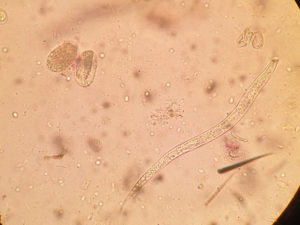
Unidentified nematodes in the feces of a leaf chameleon: on the left two eggs, the right one with a larva in it, on the right a whole worm, 100x magnification
Rhabditis are certain nematodes that are characterized primarily by a very interesting route of infection. Infected chameleons excrete infective third larval stage, L3, with their feces. These larval stages in the feces can now infect another chameleon if it accidentally ingests the remains of the feces while eating. Infected females may leave larvae on the eggshell when they lay eggs that pass through the cloaca. This can later infect newly hatched young. However, both of these happen very rarely. Much more common is a completely different route of infection: the infective larvae actively migrate from the fallen feces. They “search”, so to speak, for a new host, another chameleon. If they find another chameleon in the seams, they penetrate the animal’s subcutaneous tissue via the skin until they finally reach blood vessels. The bloodstream then allows rhabditis to carry themselves into the chameleon’s lungs. Threadworms, however, do not belong in a chameleon’s lungs. The chameleon’s body reacts to this by producing mucus and causing inflammation of the lungs or air sac. The infested chameleon increasingly shows respiratory problems. Only low levels of infestation remain without signs of disease. In the lungs, however, the journey of the rhabditis is far from over. They migrate up the trachea, are swallowed in the pharynx, and land via the esophagus and stomach in the small intestine. There, only the development of the larva is completed. The females produce rhabditis eggs by means of parthenogenesis – without the need for a male, they virtually “clone” themselves – or sexually if males are available. However, some larvae migrate from the intestine to other body organs and go into hypobiosis there. “Visible” disease caused by rhabditis usually results from suboptimal husbandry conditions with consistently high temperatures and humidity. Treatment of diseased chameleons is in principle easy at the veterinarian. However, the lung stages of the parasites can cause far-reaching problems.
Nematodes: Strongylidae
The Strongylidae also have an interesting infection route. They migrate from the fallen feces of an infected chameleon. If they find another chameleon, they penetrate the skin and embark on a journey through the body of the infected animal. Not all Strongylidae are equally pathogenic. In the chameleon, the parasites live in the intestine, but also live freely in body cavities, lungs, nose, or subcutaneous tissue. Unfortunately, unlike almost all other nematodes, Strongylidae are very difficult to treat with medications at the veterinarian. They seem to be resistant to common, well-tolerated drugs that kill other nematodes very reliably.
Nematodes: Spirurida
Spirurida live in the stomach walls of infected chameleons. Spirurida always require an arthropod (for example, an insect or a millipede) as an intermediate host. This intermediate host must be eaten by the chameleon in order for it to become infected. Therefore, these nematodes are not encountered too often in chameleons. Wild-caught chameleons are affected from time to time, captive-breds are not
Nematodes: Filarioidea (Filaria)
Filariae are thin nematodes that can grow from a few millimeters to eight centimeters in length. Their infective stages are transmitted exclusively by certain mosquitoes, so this nematode is found only in wild chameleons on Madagascar or infected imported wild-caughts. The first larval stage in the blood, L1, is called microfilariae. These microfilariae travel with the bloodstream through various body organs and continue to develop. When fully grown, the parasites are called macrofilariae. The macrofilariae migrate to the coelomic cavity, the lungs or air sacs, or the subcutis. In the hypodermis, they can be seen on the chameleon as small, moving worms that often appear to disappear with light finger pressure.
A small infestation does not lead to disease. However, mass infestations can lead to filariasis. In this case, microfilariae clog blood vessels and cause the tissue actually supplied by the affected blood vessels to die. The migration of macrofilariae within the coelomic cavity can also lead to minor local inflammation and even peritonitis. In the worst case, this can be fatal for the chameleon.
In chameleons, especially Foleyella furcata is quite common in wild-caught specimens. Since filariae always require a mosquito as an intermediate host, this parasitosis does not require disinfection of the terrarium to prevent transmission. A chameleon cannot become infected with the filariae even if it inhabits the same terrarium after the infected chameleon. However, it cannot be ruled out with absolute certainty that European, Asian or American mosquitoes could not also carry microfilariae from chameleon to chameleon. Theoretically, treatment of the chameleon itself would be sufficient to terminate a filarial infestation. However, similar to the Strongylidae, filariae are unfortunately very difficult to treat with medication at the veterinarian. They seem to be resistant to common, well-tolerated drugs that kill most other nematodes very reliably.
Nematodes: Ascaridida (Roundworms)
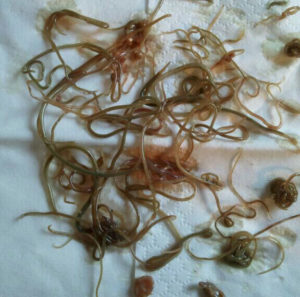
Spulwürmer aus der Bauchhöhle eines Pantherchamäleons, das an den Folgen des massiven Befalls verstorben ist
Roundworms are found in almost all mammals and reptiles. When fully grown, they look like thick spaghetti and are thus the “classic” nematode. In relation to the body size of their host, roundworms can reach impressive lengths or sizes. The roundworm of humans, for example, can grow up to 40 cm long! In lizards, the genera Diaphanocephaloidea, Oswaldocruzia, Kalicephalus, Ophiotaenia, Proeocephalus, and Crepidobohyrium occur, in chameleons from time to time Heterakis, Ascaris, Hexametra, and Orneoascaris. Roundworms in chameleons grow up to 12 cm long.
Infected chameleons excrete large amounts of roundworm eggs in their feces. The eggs contain the first larval stage, L1. With adequate humidity and warmth (22-25°C is optimal), the L1 in the eggs continues to develop into the infective third larval stage, L3. The feces fall on leaves, branches, and soil. Everywhere the droppings fall, the roundworm eggs stick. And anything that has come into contact with the feces – be it insects that have walked over it or a human hand that was cleaning up something in the terrarium – can carry the eggs further.
These eggs, in turn, infect other chameleons by inadvertently ingesting the eggs into their mouths during tongue-testing behavior or food intake. The roundworm eggs are swallowed and eventually end up in the small intestine. There, the larva hatches and develops into an adult roundworm. In the intestines, roundworms can cause bloody ulcers, perforated intestinal walls, and constipation due to mass infestation. In the worst cases, constipation ends in a fatal intestinal obstruction. Roundworms also undertake migrations outside the small intestine. Some species even infiltrate the skin. In chameleons, an untreated roundworm infestation can quickly become fatal.
The infective eggs are extremely long-lived and can survive in moist soil for years. Roundworm eggs are resistant to most chemical disinfectants. Sterilium, which is used to disinfect hands in humans, or the disinfectants commonly found in pet stores for terrariums are unfortunately useless against roundworm eggs. Ammonia or p-chloro-m-cresol should only be used in consultation with a veterinarian due to its harmful effects. Since roundworm eggs are invisible to the naked eye but are usually present in large numbers in the vicinity of infected chameleons, they are readily carried on unnoticed. Thus, unseen by humans, roundworm eggs travel from terrarium to terrarium, at fairs to new keepers, and with feeder boxes to new hosts. The good news about roundworms: Medication treatment for the chameleon at the veterinarian is simple and well-tolerated.
Nematoden: Oxyurida (pinworms)
Oxyurans are also called pinworms. This very small genus of nematodes is very common in reptiles. Oxyura species are very host-specific. This means that virtually every reptile species has its own pinworms. Or, in other words, the pinworms of turtles do not like chameleons or snakes and vice versa. Infected chameleons excrete pinworm eggs with their feces, which then adhere to the environment. The eggs contain the first larval stage, L1, which continues to develop in the environment into the infective third larva, L3. The eggs with the infective larvae can then infect other chameleons if they ingest leaves with eggs on them or insects that have passed over the feces of an infected chameleon. The eggs are swallowed with feeders and travel down the esophagus and stomach to the intestines. There, the pinworm larvae hatch from the eggs and continue to develop into adult oxyurans. The female awl tails then lay eggs again themselves, which are excreted in the feces and begin a new life cycle.
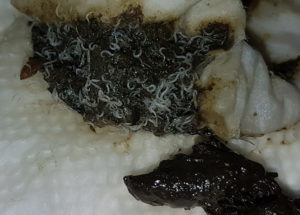
Mass infestation with oxyurids, already visible to the naked eye in the feces – this animal already had an unnoticed and accordingly untreated infestation for years
Oxyurans are pathogenic in chameleons only at high levels of infestation. Often they remain completely undetected until the first fecal examination. The eggs are not visible to the human eye. Eggs remain infectious in the terrarium for months and are therefore especially likely to be accidentally carried from animal to animal. An infestation of chameleons is very easy to treat at the vet. It is best to start the treatment including cleaning and disinfection of the terrarium already when the chameleon does not show any symptoms of disease. Otherwise, if the chameleon becomes ill later on, the pinworms can multiply rapidly and lead to oxyuriasis, an infestation with clear signs of disease.
Nematodes: Capillaria (hair worms)
Hairworms are thin and quite long threadworms. There are about 300 different species, but only a few of them are important for chameleons. They live in the small intestine and grow up to 8 cm long. Infected chameleons excrete hairworm eggs with their feces. Even the first larval stage, L1, is infectious. The eggs develop only at high humidity and about 20-24°C. In some hairworm species, earthworms ingest the hairworm eggs as intermediate hosts. The first larval stage then hatches from the egg in the earthworm, migrates through the earthworm’s body, and only there develops into the larva infective for the final host, the chameleon. Hairworm eggs easily survive temperature fluctuations down to -7°C and +12°C over two weeks.
Ectoparasites
Acari (mites and ticks)
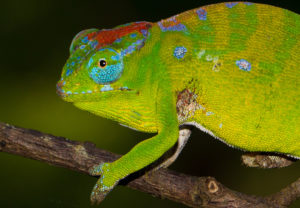
Mites in the axilla of a female Furcifer petteri-Weibchens in Amber Mountain rainforest
Mites and ticks belong to the arachnids and develop from an egg to a larva and via a certain number of nymphs to an adult parasite. The larvae have three pairs of legs, the adults four. In some species, a nymph already hatches from the egg. Between the different stages, there is a molt and a blood meal.
Mites
Mites are biting-sucking arachnids that prefer to be found around the eyes, in skin folds such as the armpit, and around the cloaca of a chameleon. Most mites are 0.2-2 mm in size and dark brown to reddish in color. They can be easily seen as small red dots with the naked eye when looking closely or with a magnifying glass. In very severe infestations, anemia can occur, and itching also occurs. On Madagascar, mites are found quite often on chameleons.
Ticks
Mostly ticks of the genus Ixodidae, which have a dorsal shield made of chitin, sit on lizards. The Haller’s organ in the tarsi of the first pair of legs enables the tick to recognize potential hosts. The development of shield ticks occurs through the egg, larval, and nymphal stages to the adult. After a blood meal, the tick can survive a long starvation period. Larvae and males of some species survive entirely without blood. Fully sucked females can grow up to three inches long. Tick infestations can occur in outdoor husbandry but seem to be almost non-existent in chameleon husbandry.
Hirudinea (leeches)
Leeches are common in Madagascar, but they seem to infest chameleons very rarely. Unfortunately, studies on leeches infesting reptiles are rather scarce. There are some studies on the infestation of turtles and crocodiles with different species of leeches. There has been no research on the occurrence of leeches on chameleons in Madagascar. We have observed a leech once on a Calumma amber in the Amber Mountain. It was not possible to verify if the observation was a coincidence or if the leech really sucked blood from the chameleon. So there would still be an exciting field of research here.

